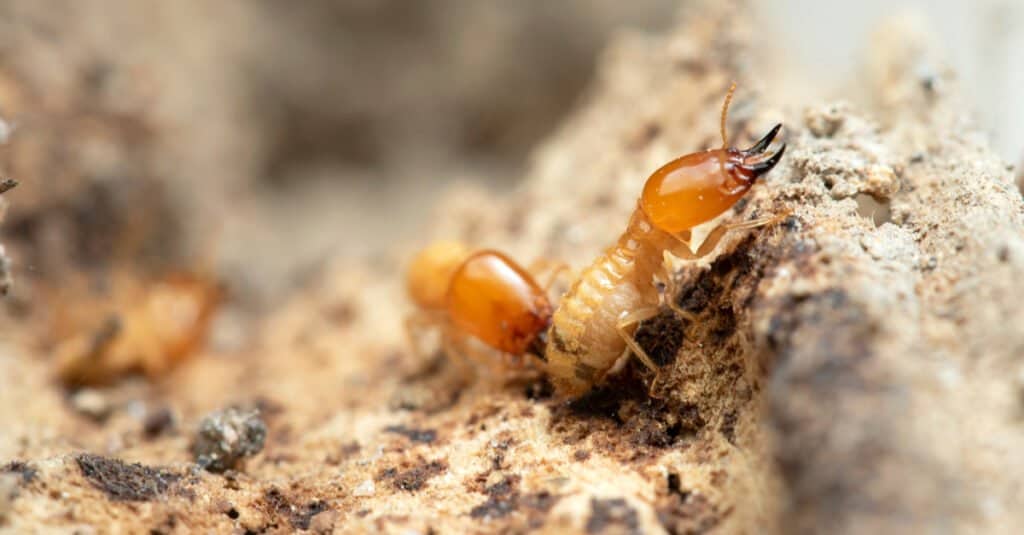Managing your property is a task all in itself, let alone when there are structural problems. Unfortunately, millions of homes across the world are affected by structural damage each year. There are many causes of structural damage, especially as it relates to wood. In the United States, there are two primary causes of damage to wood: termites and wood rot. Today, we are going to be looking at the difference between the two and learning exactly how to identify which you have. Let’s discover together – Termite Damage vs. Wood Rot: How To Tell The Difference?
Termite Damage vs. Wood Rot: How To Tell The Difference
Before we get into how to identify termites and wood rot, we need to understand what they are!
Termites

Termites are small insects that eat wood and use it to build their nests.
©bamgraphy/Shutterstock.com
Termites are small insects that live in large colonies, similar to ants. There are many termite species, but in the United States, most colonies have between 60,000 and 1 million individuals. As colony insects, they have workers, queens, and the like, just as ants would. What makes termites different, however, is their preferred food source. Certain species of termite eat wood or utilize it as a building resource in their colonies. For structures that are made of wood, termites are essentially small demolition creatures. A termite colony of around 60,000 can eat the equivalent of a 2×4 wooden beam over the course of a few months. As time goes up and the colony grows, termites can cause serious damage.
Wood rot
Wood rot isn’t an insect; rather, the result of environmental factors on wood. Most people recognize two forms of wood rot: wet rot and dry rot. Both forms are detrimental to wood and negatively impact the structural integrity of it.
Wet rot is pretty much what it sounds like. Constant moisture exposure to wood can result in a lack of structural integrity, especially as time goes on. Leaky pipes, a bad roof, and intense condensation are all causes of wet rot and need immediate addressing.
Dry rot is caused by the presence of a special fungus that needs specific conditions to live. Dry rot isn’t totally “dry” either. Most dry rot occurs in conditions with 20-30% humidity with poor ventilation. Dry rot is crumbly and spongy but can easily look like regular wood when not examined closely.
Termite Damage vs. Wood Rot: Texture
Wood that has been affected by termites has a distinct texture that can help us. From the outside, most wood can feel totally normal, making it difficult to tell on texture alone. There are two types of termites in the United States, however, and both prefer different wood. Dampwood termites are the most common and generally only eat wood that is damp or slightly wet. If the wood in your basement, crawlspace, or attic is slightly damp, this could be an easy first sign. Drywood termites do exist in the United States; they are just much rarer.
Wood rot often has a textural tell, unlike termite infestations. Dry rot is normally crumbly, flaky, and can often be broken off in chunks by hand. Additionally, the wood has damp spots, often with cobweb-feeling growths that are actually the fungal growth eating away at the wood.
Wet rot is present in places with high moisture levels and can usually be felt. Wood isn’t just damp, it’s wet. It has a mushy feel to it that is almost spongy-like. If it was previously affected by wet rot and has since dried, the wood will feel dry and crumble into little particles easily.
Termite Damage vs. Wood Rot: Appearance
Termites are small insects and leave signs where they go. One of the best ways to tell if termites are eating wood is to look for termite holes. These small holes are about 1/8th of an inch wide (about the size of a mustard seed). Additionally, the wood kicked out from these holes falls to the ground near the wood itself and looks like a small pile of seeds. In other places where termites have been feeding, sawdust gathers on the ground as they burrow into the wood further. If you can see small holes, can locate sawdust, or simply see small bugs crawling near the wood, it could be termites.
Dry rotted wood has a telltale look that is caused by the mycelium that is growing inside. The wood usually has a brittle appearance, and fungal growth is often visible on the outside or within the wood itself. If there was paint on the wood, it is often crumbling away and visibly cracking off.
Wet rot can often look wet in appearance if the leak that caused it is still present. Additionally, wet, rotting wood usually has a darker appearance and can appear black. Most people would say that wet rot wood looks “moldy,” although mold causes both wet and dry rot. Paint on wet rot is soggy, dull, and discolored.
Adjacent conditions
Termites don’t normally go after homes unless the conditions are ideal for them. Termites like places that have damp wood to feed on. They can get into homes through mulch in gardens or wood piles that house termites being too close to the home. Still, the biggest factors are all dependent on the species, so an examination is usually best.
Wood rot in all its forms is caused by the presence of water or humidity. Dry rot sucks the moisture from once damp wood, while wet rot thrives on wood damaged by water. If you have leaks, humidity problems, or old pipes, rot is a serious concern.
Thank you for reading! Have some feedback for us? Contact the AZ Animals editorial team.








